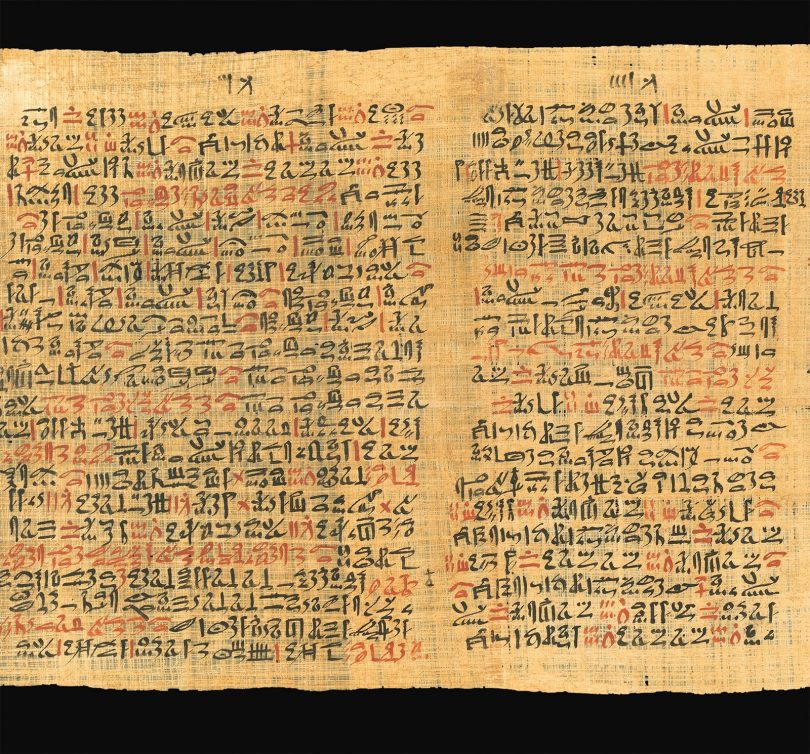Despite the ridiculousness of there being a KFC/Pizza Hut 0.6 mile from the Great Pyramids at Giza (see Google Maps), and sacrilegious flotsam floating around when a wind kicks up (see Karl Pilkington in An Idiot Abroad, Season 1), ancient Egyptian marvels are still monolithic, wondrous sights to behold. Ancient Egypt mesmerizes us with architectural, cultural (e.g., beer), mathematical (like using a number close to 22/7, aka pi, in architecture [1]), and intellectual achievements. Perhaps some of their creativity and intellectual prowess came from their acceptance and understanding of cannabis?

The Egyptian word shemshemet has been reported to refer to Cannabis sativa. A passage written in the Pyramid Texts uses the word, reading: “The King has tied the cords of the šmšmt-plant.” [2] Ethan Russo commented in his review of cannabis history that this may be the earliest written account of cannabis, as the text has been dated to approximately 2350 B.C.E. [2] The Ebers Papyrus (pictured), dated to approximately 1534 B.C.E., details the medical knowledge of the time, including the use of cannabis for ailments like inflammation. [2,3] Even the Sumerians, the originators of written language, are thought to have dedicated a word for cannabis – A.ZAL.LA. [2]
The medical aspects of C. sativa in ancient Egypt aren’t really doubted. Cannabis may have been beneficial in treating a plague caused by a bacterium Yersinia pestis. [2,4] In a book chapter written by Raphael Mechoulam, cannabis is said to have been used as an oral medication for “mothers and children.” [5] Mechoulam postulates that this refers to the prevention of hemorrhaging during childbirth. [5] Others have ascribed Egyptian usage of cannabis in enemas, bladder diseases, rectal diseases, eye medications, ointments, antiseptics, analgesics, and apparently sore toenails which must have been a thing back then. [2,5,6]
In the Papyrus Ramesseum III, a verse reads: “A treatment for the eyes: celery; hemp; is ground and left in the dew overnight. Both eyes of the patient are to be washed with it early in the morning.” [2,7] Russo suggested that this could indicate a treatment for glaucoma or at least inflammation. [2]
The more interesting question, however, regards whether the brilliant ancient Egyptians utilized cannabis for its intoxicating powers. There really hasn’t been a firm answer; however, one study quotes William O’Shaughnessy as saying: “The narcotic effects of Hemp are popularly known in the south of Africa, South America, Turkey, Egypt, Middle East Asia, India, and the adjacent territories of the Malays, Burmese, and Siamese. In all these countries, Hemp is used in various forms, by the dissipated and depraved, as the ready agent of a pleasing intoxication.” [8] How far back that popularity stretched, though, isn’t clear.
Archaeologists discovered hemp fibers in the tomb of Akhenaten [2,9] and cannabis pollen turned up inside the mummy of Rameses the Second [2,10]. Even more germane, the hair on the ancient priestess Henut Taui’s mummy reportedly contained traces of hashish along with cocaine and nicotine. [11] Researchers couldn’t gauge whether the concentrations of the drugs reflected the “original amount of these drugs during life or immediately after death, or what kind of decomposition might have taken place in the past 3000 years.” Unfortunately, the dominant story became the cocaine and nicotine, as no one expected them to have been cultivated in the region whatsoever.
Getting more cosmic, Seshat, the goddess of wisdom, knowledge, and writing, and companion of Thoth, who was also into writing and wisdom and science, is often depicted with what could be a 7-leafed plant above her head (pictured). Some have likened the image to C. sativa.
There’s something hypnotic about ancient Egypt, from the gods to the structures and the lore that drapes over them. We could likely learn so much from their oddly cerebral ways. It’s agreed that the ancient Egyptians regarded cannabis as medicinal. Knowing that the ancient Egyptians used cannabis to go outside of the box and create things that are still treasured and still causing bewilderment would be a wonderfully time-transcending validation of the plant’s full power.
Image Credits: Papyrus Ebers, Ancient History Encyclopedia
References
- Cooper, L. “Did Egyptian Scribes Have an Algorithmic Means for Determining the Circumference of a Circle?” Historia Mathematica, Vol. 38, Issue 4, 2011, pp. 455-484. [journal impact factor = 0.500; cited by 3 (ResearchGate)]
- Russo, E. “History of Cannabis and Its Preparations in Saga, Science, and Sobriquet.” Chemistry & Biodiversity, vol.4, 2007, pp.1614-1648. [journal impact factor = 1.449; cited by 204 (ResearchGate)]
- Epstein, H.A. “A Natural Approach to Soothing Atopic Skin.” Skinmed, vol.8, 2010, pp. 95–97. [journal impact factor = 0.350; cited by 3 (ResearchGate)]
- Aubert-Roche, Louis R. “De La Peste, Ou, Typhus D’orient: Documens Et Observations Recueillis Pendant Les Années 1834 a 1838, En Egypte, En Arabie, Sur La Mer Rouge, En Abyssinie, a Smyrne Et a Constantinople: Suivis D’un Essai Sur Le Hachisch Et Son Emploi Dans Le Traitement De La Peste, Et D’un Mémoire Sur La Prophylaxie Générale De La Peste.” Paris: Just Rouvier, 1843, p.400.
- Mechoulam, R. “The Pharmacohistory of Cannabis sativa.” Cannabinoids as Therapeutic Agents, edited by Mechoulam, R., 1986, CRC Press, Boca Raton, Florida. [cited by 59 (ResearchGate)]
- Kabelik, J., Krejci, Z. and Santavy, F. “Cannabis as a Medicament.” United Nations Office on Drugs and Crime, 1960.
- Manniche, L. “An Ancient Egyptian Herbal.” University of Texas, Austin, 1989, p. 176.
- Fankhauser M. “History of Cannabis in Western Medicine.” Cannabis and Cannabinoids, edited by Grotenhermen F, and Russo E, New York: The Haworth Integrative Healing Press, 2002, pp. 37-51. [cited by 36 (ResearchGate)]
- Martin, G.T. “Tomb of Amenophis IV,” vol. II, ed. G. T. Martin, Egypt Exploration Society, London, 1989, p. 256.
- A. Leroi-Gourhan. “Les pollens et l’embaumement,” eds. L. Balout and C. Roubet, Museum National d’ Histoire Naturelle, Musee de l’Homme, Paris, 1985, pp. 162–165.
- Balabanova, S. et al. “First Identification of Drugs in Egyptian Mummies.” Naturwissenschaften, vol. 79, no.8, 1992, pp. 358. [journal impact factor = 1.839; cited by 55 (ResearchGate)]








